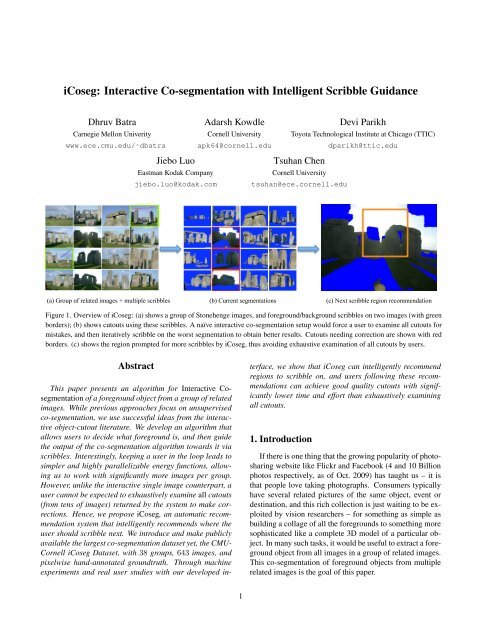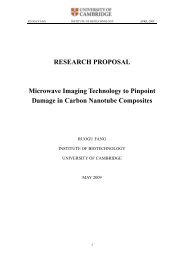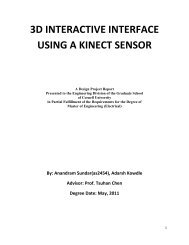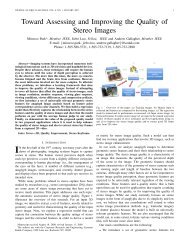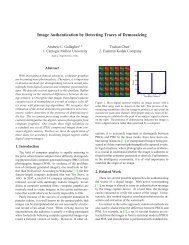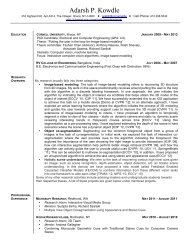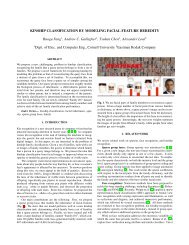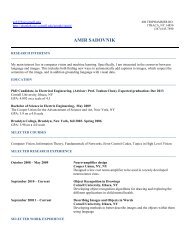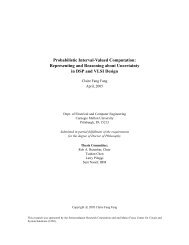iCoseg: Interactive Co-segmentation with Intelligent Scribble Guidance
iCoseg: Interactive Co-segmentation with Intelligent Scribble Guidance
iCoseg: Interactive Co-segmentation with Intelligent Scribble Guidance
Create successful ePaper yourself
Turn your PDF publications into a flip-book with our unique Google optimized e-Paper software.
<strong>i<strong>Co</strong>seg</strong>: <strong>Interactive</strong> <strong>Co</strong>-<strong>segmentation</strong> <strong>with</strong> <strong>Intelligent</strong> <strong>Scribble</strong> <strong>Guidance</strong><br />
Dhruv Batra<br />
Carnegie Mellon Univerity<br />
www.ece.cmu.edu/˜dbatra<br />
Jiebo Luo<br />
Eastman Kodak <strong>Co</strong>mpany<br />
jiebo.luo@kodak.com<br />
Adarsh Kowdle<br />
<strong>Co</strong>rnell University<br />
apk64@cornell.edu<br />
Devi Parikh<br />
Toyota Technological Institute at Chicago (TTIC)<br />
Tsuhan Chen<br />
<strong>Co</strong>rnell University<br />
tsuhan@ece.cornell.edu<br />
dparikh@ttic.edu<br />
(a) Group of related images + multiple scribbles (b) Current <strong>segmentation</strong>s (c) Next scribble region recommendation<br />
Figure 1. Overview of <strong>i<strong>Co</strong>seg</strong>: (a) shows a group of Stonehenge images, and foreground/background scribbles on two images (<strong>with</strong> green<br />
borders); (b) shows cutouts using these scribbles. A naïve interactive co-<strong>segmentation</strong> setup would force a user to examine all cutouts for<br />
mistakes, and then iteratively scribble on the worst <strong>segmentation</strong> to obtain better results. Cutouts needing correction are shown <strong>with</strong> red<br />
borders. (c) shows the region prompted for more scribbles by <strong>i<strong>Co</strong>seg</strong>, thus avoiding exhaustive examination of all cutouts by users.<br />
Abstract<br />
This paper presents an algorithm for <strong>Interactive</strong> <strong>Co</strong><strong>segmentation</strong><br />
of a foreground object from a group of related<br />
images. While previous approaches focus on unsupervised<br />
co-<strong>segmentation</strong>, we use successful ideas from the interactive<br />
object-cutout literature. We develop an algorithm that<br />
allows users to decide what foreground is, and then guide<br />
the output of the co-<strong>segmentation</strong> algorithm towards it via<br />
scribbles. Interestingly, keeping a user in the loop leads to<br />
simpler and highly parallelizable energy functions, allowing<br />
us to work <strong>with</strong> significantly more images per group.<br />
However, unlike the interactive single image counterpart, a<br />
user cannot be expected to exhaustively examine all cutouts<br />
(from tens of images) returned by the system to make corrections.<br />
Hence, we propose <strong>i<strong>Co</strong>seg</strong>, an automatic recommendation<br />
system that intelligently recommends where the<br />
user should scribble next. We introduce and make publicly<br />
available the largest co-<strong>segmentation</strong> dataset yet, the CMU-<br />
<strong>Co</strong>rnell <strong>i<strong>Co</strong>seg</strong> Dataset, <strong>with</strong> 38 groups, 643 images, and<br />
pixelwise hand-annotated groundtruth. Through machine<br />
experiments and real user studies <strong>with</strong> our developed in-<br />
1<br />
terface, we show that <strong>i<strong>Co</strong>seg</strong> can intelligently recommend<br />
regions to scribble on, and users following these recommendations<br />
can achieve good quality cutouts <strong>with</strong> significantly<br />
lower time and effort than exhaustively examining<br />
all cutouts.<br />
1. Introduction<br />
If there is one thing that the growing popularity of photosharing<br />
website like Flickr and Facebook (4 and 10 Billion<br />
photos respectively, as of Oct. 2009) has taught us – it is<br />
that people love taking photographs. <strong>Co</strong>nsumers typically<br />
have several related pictures of the same object, event or<br />
destination, and this rich collection is just waiting to be exploited<br />
by vision researchers – for something as simple as<br />
building a collage of all the foregrounds to something more<br />
sophisticated like a complete 3D model of a particular object.<br />
In many such tasks, it would be useful to extract a foreground<br />
object from all images in a group of related images.<br />
This co-<strong>segmentation</strong> of foreground objects from multiple<br />
related images is the goal of this paper.
(a) Stone-pair [23]. (b) Stonehenge-pair from CMU-<strong>Co</strong>rnell <strong>i<strong>Co</strong>seg</strong> Dataset.<br />
Figure 2: What is foreground? The stone-pair (a) has significant variation in background <strong>with</strong> nearly identical foreground and thus<br />
unsupervised co-<strong>segmentation</strong> can easily extract the stone as foreground. The Stonehenge-pair is fairly consistent as a whole and thus<br />
the stones cannot be cut out via unsupervised co-<strong>segmentation</strong>. Bringing a user in the loop is necessary for the problem of foreground<br />
extraction to be well defined.<br />
Most existing works on co-<strong>segmentation</strong> [13, 21, 23]<br />
work <strong>with</strong> a pair of images <strong>with</strong> similar (sometimes nearly<br />
identical) foreground, and unrelated backgrounds (e.g. the<br />
“Stone-pair” in Figure 2). This property is necessary because<br />
the goal of these works is to extract the common foreground<br />
object automatically, <strong>with</strong>out any user-input. Due<br />
to the nature of our application (i.e. multiple images of the<br />
same event or subject), our images typically do not follow<br />
this property (see Figure 2). Hence, <strong>with</strong>out user-input, the<br />
task of extracting the foreground object “of interest” is illdefined.<br />
This paper deals <strong>with</strong> <strong>Interactive</strong> <strong>Co</strong>-<strong>segmentation</strong> of a<br />
group (typically ≫ 2) of related images, and presents an<br />
algorithm that enables users to quickly guide the output of<br />
the co-<strong>segmentation</strong> algorithm towards the desired output<br />
via scribbles. Our approach uses successful ideas from the<br />
single-image interactive <strong>segmentation</strong> [6, 19, 22] literature.<br />
A user provides foreground/background scribbles on one<br />
(or more) images from a group and our algorithm uses these<br />
scribbles to produce cutouts from all images this group.<br />
In a single-image setup, a user visually inspects the produced<br />
cutout and gives more scribbles to correct mistakes<br />
made by the algorithm. However, this approach would not<br />
work for interactive co-<strong>segmentation</strong> because 1) as the number<br />
of images in the group increases, it becomes increasingly<br />
cumbersome for a user to iterate through all the images<br />
in the group to find the worst <strong>segmentation</strong>; and 2) even<br />
if the user were willing to identify an incorrect cutout, there<br />
might be multiple incorrect cutouts in the group, some more<br />
confusing to the <strong>segmentation</strong> algorithm than others. Observing<br />
labels on the most confusing ones first would help<br />
reduce the number of user annotations required. It is thus<br />
necessary for the algorithm to be able to suggest regions in<br />
images where scribbles would be the most informative.<br />
<strong>Co</strong>ntributions. The main contributions of this paper are:<br />
• We present the first algorithm for intelligent <strong>Interactive</strong><br />
<strong>Co</strong>-<strong>segmentation</strong> (<strong>i<strong>Co</strong>seg</strong>), that automatically suggests<br />
regions where the user should scribble next.<br />
• We introduce (and show results on) the largest co<strong>segmentation</strong><br />
dataset yet, the CMU-<strong>Co</strong>rnell <strong>i<strong>Co</strong>seg</strong><br />
dataset, containing 38 groups <strong>with</strong> 17 images/group<br />
on average (total 643 images) and pixelwise handannotated<br />
groundtruth. We make this dataset (and annotations)<br />
publicly available [3] to facilitate further<br />
work, and allow for easy comparisons.<br />
• We develop a publicly available interface [3] for interactive<br />
co-sgementation. We present results of simulated<br />
machine experiments as well as real user studies<br />
on our interface. We find that <strong>i<strong>Co</strong>seg</strong> can intelligently<br />
recommend regions to scribble on, and help users<br />
achieve good quality cutouts <strong>with</strong> significantly lower<br />
time and effort than having to examine all cutouts exhaustively.<br />
Technique. Our approach is composed of two main parts:<br />
1) an energy minimization framework for interactive co<strong>segmentation</strong>;<br />
and 2) a scribble guidance system that uses<br />
active learning and some intuitive cues to form a recommendation<br />
map for each image in the group. The system recommends<br />
a region <strong>with</strong> the highest recommendation score. See<br />
Figure 1 for an overview.<br />
Organization. The rest of this paper is organized as<br />
follows: Section 2 discusses related work; Section 3<br />
presents our energy minimization approach to interactive<br />
co-<strong>segmentation</strong> of a group of related images; Section 4<br />
presents our recommendation scheme for guiding user<br />
scribbles; Section 5 introduces our benchmark dataset; Section<br />
6 discusses the results of simulated machine experiments<br />
and a real user-study; Finally, Section 7 concludes<br />
the paper.<br />
2. Related Work<br />
Unsupervised <strong>Co</strong>-<strong>segmentation</strong>. Rother et al. [23] introduced<br />
the problem of (unsupervised) co-<strong>segmentation</strong>
of image pairs. Their approach is to minimize an energy<br />
function that is a combination of the usual MRF<br />
smoothness prior and a histogram matching term that forces<br />
foreground histograms of images to be similar. Mu et<br />
al. [20] extend this framework <strong>with</strong> quadratic global constraints.<br />
More recently, Mukherjee et al. [21] proposed<br />
half-integrality algorithms, and Hochbaum et al. [13] modified<br />
the histogram matching term to propose max-flow<br />
based algorithms. The common theme here is unsupervised<br />
co-<strong>segmentation</strong>, which is achieved by forcing histogram<br />
consistency between foregrounds. As noted earlier,<br />
this would fail for pairs <strong>with</strong> related backgrounds (see<br />
Figure 2), where the problem of identifying the foreground<br />
objects is ill-posed. This is where our work of interactive<br />
co-<strong>segmentation</strong> fits in, which allows a user to indicate the<br />
foreground objects through simple scribbles. In addition,<br />
these works involve specific constructions and solutions for<br />
image pairs, while our technique naturally generalizes to<br />
multiple images (Section 3).<br />
Supervised <strong>Co</strong>-<strong>segmentation</strong>. Schnitman et al. [24] and<br />
Cui et al. [12] learn to segment from a single fully segmented<br />
image, and then “induce” [24] or “transduce” [12]<br />
<strong>segmentation</strong>s on a group of related images. We, on the<br />
other hand, utilize very sparse user interaction (in the form<br />
of scribles), which are not restricted to a single image and<br />
can be provided on multiple images in a group if desired.<br />
<strong>Interactive</strong> Image Segmentation. Boykov and Jolly [6]<br />
posed interactive single-image <strong>segmentation</strong> given user<br />
scribbles as a discrete optimization problem. Li et al. [19]<br />
and Rother et al. [22] presented simplified user interactions.<br />
Bai et al. [2] and Criminisi et al. [11] proposed techniques<br />
built on efficient geodesic distance computations. Our approach<br />
to multiple-image interactive co-<strong>segmentation</strong>, as<br />
described in the next section, is a natural extension of<br />
Boykov and Jolly [6].<br />
Active Learning. Related to our paper are works on active<br />
learning where algorithms are able to choose the data<br />
they learn from by querying the labelling oracle. This is a<br />
vast sub-field of machine learning and we refer the reader to<br />
Settles [25] for a detailed survey. In computer vision, active<br />
learning has been used for object categorization [15], classifying<br />
videos [28], ranking images by informativeness [27]<br />
and creating large datasets [9]. More recently, Kolhi et<br />
al. [16] showed how to measure uncertainties from graphcut<br />
solutions and suggested that these may be helpful in interactive<br />
image <strong>segmentation</strong> applications. To the best of<br />
our knowledge, this is the first paper to use uncertainties to<br />
guide user scribbles.<br />
3. <strong>i<strong>Co</strong>seg</strong>: Energy Minimization<br />
Energy Minimization. Given user scribbles indicating<br />
foreground / background, we cast our labelling problem<br />
as minimization of Gibbs energies defined over<br />
graphs constructed over each image in a group. Specifically,<br />
consider a group of m image-scribble pairs D =<br />
{(X (1) , S (1) ), (X (2) , S (2) ), . . . , (X (m) , S (m) )}, where the<br />
k th image is represented as a collection of nk sites to be<br />
labelled, i.e. X (k) = {X (k)<br />
1<br />
, X(k)<br />
2<br />
, . . . , X(k)<br />
nk }, and scrib-<br />
bles for an image S (k) are represented as the partial (potentially<br />
empty) 1 set of labels for these sites. For computational<br />
efficiency, we use superpixels as these labelling sites<br />
(instead of pixels). 2 For each image (k), we build a graph,<br />
G (k) = (V (k) , E (k) ), over superpixels, <strong>with</strong> edges connecting<br />
adjacent superpixels.<br />
Using these labelled sites, we learn a group appearance<br />
model A = {A1, A2}, where A1 is the first-order (unary)<br />
appearance model, and A2 the second-order (pairwise) appearance<br />
model. This appearance model (A) is described<br />
in detail in the following sections. We note that all images<br />
in the group share a common model, i.e. only one model is<br />
learnt. Using this appearance model, we define a collection<br />
of energies over each of the m images as follows:<br />
E (k) (X (k) : A) = <br />
+ λ <br />
i∈V (k)<br />
(i,j)∈E (k)<br />
Ei(X (k)<br />
i<br />
Eij<br />
: A1)<br />
<br />
X (k)<br />
i , X (k)<br />
<br />
j : A2 , (1)<br />
where the first term is the data term indicating the cost of assigning<br />
a superpixel to foreground and background classes,<br />
while the second term is the smoothness term used for penalizing<br />
label disagreement between neighbours. Note that<br />
the (:) part in these terms indicates that both these terms are<br />
functions of the learnt appearance model. From now on,<br />
to simplify notation, we write these terms as Ei(Xi) and<br />
Eij(Xi, Xj), and the dependence on the appearance model<br />
A and image (k) is implicit.<br />
Data (Unary) Term. Our unary appearance model consists<br />
of a foreground and background Gaussian Mixture Model,<br />
i.e., A1 = {GMMf , GMMb}. Specifically, we extract<br />
colour features extracted from superpixels (as proposed by<br />
Hoiem et al. [14]). We use features from labelled sites in<br />
all images to fit foreground and background GMMs (where<br />
number of gaussians was automatically learnt by minimizing<br />
an MDL criteria [5]). We then use these learnt GMMs<br />
to compute the data terms for all sites, which is the negative<br />
log-likelihood of the features given the class model.<br />
Smoothness (Pairwise) Term. The most commonly used<br />
smoothness term in energy minimization based <strong>segmentation</strong><br />
methods [11, 12, 22] is the contrast sensitive Potts<br />
model:<br />
E(Xi, Xj) = I (Xi = Xj) exp(−βdij), (2)<br />
1 Specifically, we require at least one labelled foreground and background<br />
site to train our models, but only one per group, not per image.<br />
2 We use mean-shift [10] to extract these superpixels, and typically<br />
break down 350×500 images into 400 superpixels per image.
where I (·) is an indicator function that is 1(0) if the input<br />
argument is true(false), dij is the distance between features<br />
at superpixels i and j and β is a scale parameter. Intuitively,<br />
this smoothness term tries to penalize label discontinuities<br />
among neighbouring sites but modulates the penalty via a<br />
contrast-sensitive term. Thus, if two adjacent superpixels<br />
are far apart in the feature space, there would be a smaller<br />
cost for assigning them different labels than if they were<br />
close. However, as various authors have noted, this contrast<br />
sensitive modulation forces the <strong>segmentation</strong> to follow<br />
strong edges in the image, which might not necessarily correspond<br />
to object boundaries. For example, Cui et al. [12]<br />
modulate the distance dij based on statistics of edge profile<br />
features learnt from a fully segmented training image.<br />
In this work, we use a distance metric learning algorithm<br />
to learn these dij from user scribbles. The basic intuition<br />
is that when two features (which might be far apart in Euclidean<br />
distance) are both labelled as the same class by the<br />
user scribbles, we want the distance between them to be<br />
low. Similarly, when two features are labelled as different<br />
classes, we want the distance between them to be large, even<br />
if they happen to be close by in Euclidean space. Thus, this<br />
new distance metric captures the pairwise statistics of the<br />
data better than Euclidean distance. For example, if colours<br />
blue and white were both scribbled as foreground, then the<br />
new distance metric would learn a small distance between<br />
them, and thus, a blue-white edge in the image would be<br />
heavily penalized for label discontinuity, while the standard<br />
contrast sensitive model would not penalize this edge as<br />
much. The specific choice of this algorithms is not important,<br />
and any state-of-art technique may be used. We use the<br />
implementation of Batra et al. [4].<br />
We update both A1 = {GMMf , GMMb} and A2 =<br />
{dij} every time the user provides a new scribble. Finally,<br />
we note that contrast-sensitive potts model leads to a submodular<br />
energy function. We use graph-cuts to efficiently<br />
compute the MAP labels for all images, using the implementation<br />
of Bagon [1] and Boykov et al. [7, 8, 17].<br />
<strong>Co</strong>mparing Energy Functions. Our introduced energy<br />
functions (1) are different from those typically found in co<strong>segmentation</strong><br />
literature and we make the following observations.<br />
While previous works [13, 20, 21, 23] have formulated<br />
co-<strong>segmentation</strong> of image pairs <strong>with</strong> a single energy<br />
function, we assign to each image its own energy function.<br />
The reason we are able to do this is because we model the<br />
dependance between images implicitly via the common appearance<br />
model (A), while previous works added an explicit<br />
histogram matching term to the common energy function.<br />
There are two distinct advantages of our approach. First, as<br />
several authors [13, 20, 21, 23] have pointed out, adding an<br />
explicit histogram matching term makes the energy function<br />
intractable. On the other hand, each one of our energy functions<br />
is submodular and can be solved <strong>with</strong> a single graph-<br />
cut. Second, this common energy function grows at least<br />
quadratically <strong>with</strong> the number of images in the group, making<br />
these approaches almost impossible to scale to dozens of<br />
images in a group. On the other hand, given the appearance<br />
models, our collection of energy functions are completely<br />
independent. Thus the size of our problem only grows linearly<br />
in the number of images in the group, which is critical<br />
for interactive applications. In fact, each one of our energy<br />
functions may be optimized in parallel, making our<br />
approach amenable to distributed systems and multi-core<br />
architectures. Videos embedded on our project website [3]<br />
show our (single-core) implementation co-segmenting ∼ 20<br />
image in a matter of seconds.<br />
To be fair, we should note that what allows us to set-up an<br />
efficiently solvable energy function is our incorporation of<br />
a user in the co-<strong>segmentation</strong> process, giving us partially labelled<br />
data (scribbles). While this user involvement is necessary<br />
because we work <strong>with</strong> globally related images, this<br />
involvement also means that the co-<strong>segmentation</strong> algorithm<br />
must be able to query/guide user scribbles, because users<br />
cannot be expected to examine all cutouts at each iteration.<br />
This is described next.<br />
4. <strong>i<strong>Co</strong>seg</strong>: Guiding User <strong>Scribble</strong>s<br />
In this section, we develop an intelligent recommendation<br />
algorithm to automatically seek user-scribbles and reduce<br />
the user effort. Given a set of initial scribbles from the<br />
user, we compute a recommendation map for each image<br />
in the group. The image (and region) <strong>with</strong> the highest recommendation<br />
score is presented to the user to receive more<br />
scribbles. Instead of committing to a single confusion measure<br />
as our recommendation score, which might be noisy,<br />
we use a number of “cues”. These cues are then combined<br />
to form a final recommendation map, as seen in Figure 3.<br />
The three categories of cues we use, and our approach to<br />
learning the weights of the combination are described next.<br />
4.1. Uncertainty-based Cues<br />
Node Uncertianty (NU). Our first cue is the one most commonly<br />
used in uncertainty sampling, i.e., entropy of the<br />
node beliefs. Recall that each time scribbles are received,<br />
we fit A1 = {GMMf , GMMb} to the labelled superpixel<br />
features. Using this learnt A1, for each superpixel we normalize<br />
the foreground and background likelihoods to get a<br />
2-class distribution and then compute the entropy of this<br />
distribution. The intuition behind this cue is that the more<br />
uniform the class distribution for a site, the more we would<br />
like to observe its label.<br />
Edge Uncertainty (EU). The Query by <strong>Co</strong>mmittee [26] algorithm<br />
is a fundamental work that forms the basis for many<br />
selective sampling works. The simple but elegant idea is to<br />
feed unlabelled data-points to a committee/set of classifiers
and request label for the data-point <strong>with</strong> maximal disagreement<br />
among classifier outcomes. We use this intuition to<br />
define our next cue. For each superpixel, we use our learnt<br />
distances (recall: these are used to define the edge smoothness<br />
terms in our energy function) to find K (=10) nearest<br />
neighbours from the labelled superpixels. We treat the proportion<br />
of each class in the returned list as the probability of<br />
assigning that class to this site, and use the entropy of this<br />
distribution as our cue. The intuition behind this cue is that<br />
the more uniform this distribution, the more disagreement<br />
there is among the the returned neighbour labels, and the<br />
more we would like to observe the label of this site.<br />
Graph-cut Uncertainty (GC). This cue tries to capture<br />
the confidence in the energy minimizing state returned by<br />
graph-cuts. For each site, we compute the increase in energy<br />
by flipping the optimal assignment at that site. The<br />
intuition behind this cue is that the smaller the energy difference<br />
by flipping the optimal assignment at a site, the<br />
more uncertain the system is of its label. We note that minmarginals<br />
proposed by Kohli et al. [16] could also be used.<br />
4.2. <strong>Scribble</strong>-based Cues<br />
Distance Transform over <strong>Scribble</strong>s (DT). For this cue, we<br />
compute the distance of every pixel to the nearest scribble<br />
location. The intuition behind this (weak) cue is that we<br />
would like to explore regions in the image away from the<br />
current scribble because they hold potentially different features<br />
than sites closer to the current scribbles.<br />
Intervening <strong>Co</strong>ntours over <strong>Scribble</strong>s (IC). This cue uses<br />
the idea of intervening contours [18]. The value of this cue<br />
at each pixel is the maximum edge magnitude in the straight<br />
line to the closest scribble. This results in low confusions<br />
as we move away from a scribble until a strong edge is observed,<br />
and then higher confusions on the other side of the<br />
edge. The motivation behind this cue is that edges in images<br />
typically denote contrast change, and by observing scribble<br />
labels on both sides of an edge, we can learn whether or not<br />
to respect such edges for future <strong>segmentation</strong>s.<br />
4.3. Image-level Cues<br />
The cues described so far, are local cues, that describe<br />
which region in an image should be scribbled on next. In<br />
addition to these, we also use some image-level cues (i.e.,<br />
uniform over an image), that help predict which image to<br />
scribble next, not where.<br />
Segment size (SS). We observe that when very few scribbles<br />
are marked, energy minimization methods typically<br />
over-smooth and results in “whitewash” <strong>segmentation</strong>s (entire<br />
image labelled as foreground or background). This cue<br />
incorporates a prior for balanced <strong>segmentation</strong>s by assigning<br />
higher confusion scores to images <strong>with</strong> more skewed<br />
<strong>segmentation</strong>s. We normalize the size of foreground and<br />
background regions to get class distributions for this image,<br />
(a) Image+<strong>Scribble</strong>s (b) Node Uncertainty (c) Edge Uncertainty<br />
(d) GC Uncertainty (e) Distance Transform (f) Intervening <strong>Co</strong>ntour<br />
(g) <strong>Co</strong>mbining cues<br />
Figure 3: Cues: (a) shows the image <strong>with</strong> provided scribbles; (b)-<br />
(f) show various cues; and (g) shows how these cues are combined<br />
to produce a final recommendation map.<br />
and use the inverse of the entropy of this distribution as our<br />
cue.<br />
<strong>Co</strong>deword Distribution over Images (CD). This imagelevel<br />
cue captures how diverse an image is, <strong>with</strong> the<br />
motivation being that scribbling on images containing<br />
more diversity among features would lead to better foreground/background<br />
models. To compute this cue, we cluster<br />
the features computed from all superpixels in the group<br />
to form a codebook, and the confusion score for each image<br />
is the entropy of the distribution over the codewords observed<br />
in the image. The intuition is that the more uniform<br />
the codeword distribution for an image the more diverse the<br />
appearances of different regions in the image.<br />
4.4. <strong>Co</strong>mbined Recommendation Map<br />
We now describe how we combine these various cues<br />
to produce a combined confusion map. Intuitively, the optimal<br />
combination scheme would be one that generates a<br />
recommendation map that assigns high values to regions<br />
that a user would scribble on, if they were to exhaustively<br />
examine all <strong>segmentation</strong>s. Users typically scribble on regions<br />
that are incorrectly segmented. We cast the problem<br />
of learning the optimal set of weights for our cues, as that of<br />
learning a linear classifier (logistic regression) that maps every<br />
superpixel (represented by a 7-dimensional feature vector<br />
corresponding to each of the 7 cues described above) to<br />
the (binary) <strong>segmentation</strong> error-map. Our cue combination
scheme is illustrated in Figure 3.<br />
5. The CMU-<strong>Co</strong>rnell <strong>i<strong>Co</strong>seg</strong> Dataset<br />
To evaluate our proposed approach and to establish a<br />
benchmark for future work, we introduce the largest co<strong>segmentation</strong><br />
dataset yet, the CMU-<strong>Co</strong>rnell <strong>i<strong>Co</strong>seg</strong> Dataset.<br />
While previous works have experimented <strong>with</strong> a few pairs<br />
of images, our dataset contains 38 challenging groups <strong>with</strong><br />
643 total images (∼17 images per group), <strong>with</strong> associated<br />
pixel-level ground truth. We built this dataset from the<br />
Flickr® online photo collection, and hand-labelled pixellevel<br />
<strong>segmentation</strong>s in all images. We used the “Group”<br />
feature in Flickr, where users form groups around popular<br />
themes, to search for images from this theme. Our dataset<br />
consists of animals in the wild (elephants, pandas, etc.),<br />
popular landmarks (Taj Mahal, Stonehenge, etc.), sports<br />
teams (Baseball, Football, etc.) and other groups that contain<br />
a common theme or common foreground object. For<br />
some (though not all) of the groups, we restricted the images<br />
to come from the same photographer’s photo-stream,<br />
making this a more realistic scenario. Examples of these<br />
groups are shown in various figures in this paper and more<br />
examples may be found online [3]. We note that this<br />
dataset is significantly larger than those used in previous<br />
works [13, 23]. We have made this dataset (and annotations)<br />
publicly available [3] to facilitate further work, and<br />
allow for easy comparisons.<br />
6. Experiments<br />
6.1. Machine Experiments<br />
To conduct a thorough set of experiments and evaluate<br />
various design choices, it is important to be able to perform<br />
multiple iterations <strong>with</strong>out explicitly polling a human<br />
for scribbles. Thus, we develop a mechanism to generate<br />
automatic scribbles, that mimic human scribbles (we also<br />
present results of a user-study in Section 6.2). We model<br />
these synthetic scribbles as (smooth) random walks that do<br />
not cross foreground-background boundaries. Our scribble<br />
generation technique consists of sampling a starting point<br />
in the image uniformly at random. A direction angle is then<br />
randomly sampled such that it is highly correlated <strong>with</strong> the<br />
previous direction sample (for smoothness) for the scribble,<br />
3 and a fixed-size (=30 pixels) step is taken along this<br />
direction to extend the scribble (as long as it does not cross<br />
object boundaries, as indicated by the groundtruth <strong>segmentation</strong><br />
of the image). To mimic user-scribbles given a recommendation<br />
map, the initial as well as subsequent points<br />
on the scribble are picked by considering the recommendation<br />
map to be a distribution. Using synthetic scribbles<br />
3 For the first two sampled points, there is no previous direction and this<br />
direction is sampled uniformly at random.<br />
(a) Image (b) <strong>Co</strong>nfusion Map<br />
(c) Sampled <strong>Scribble</strong>s<br />
Figure 4: Example simulated scribbles: Note that these scribbles<br />
never cross foreground boundaries (red player).<br />
Mean Rank<br />
6<br />
4<br />
2<br />
0<br />
NU EU GC DT IC SS CD<br />
Cue<br />
Figure 5: Mean ranks achieved by individual cues (see Sec 6.1).<br />
allows us to control the length of scribbles and observe the<br />
behavior of the algorithm <strong>with</strong> increasing information. Example<br />
synthetic scribbles are shown in Figure 4.<br />
We first analyze the informativeness of each of our 7<br />
cues. We start by generating a foreground and background<br />
scribble on a random image in a group. We then compute<br />
each of our cues, and treat each individual cue as a recommendation<br />
map. We generate the next synthetic scribble as<br />
guided by this recommendation map. We repeat this till we<br />
have scribbled about 1000 pixels across the group, and compute<br />
the average <strong>segmentation</strong> accuracy across the images<br />
of a group. 4 We rank the 7 cues by this accuracy. Figure 5<br />
shows the mean ranks (across groups, average of 10 random<br />
runs) achieved by these cues. Out of our cues, the graph-cut<br />
cue (GC) performs the best, while both distance transform<br />
(DT) and intervening contour (IC) are the weakest.<br />
We now evaluate <strong>i<strong>Co</strong>seg</strong>, our recommendation system,<br />
as a whole. The experimental set up is the same as that<br />
described above, except now we use the combined recommendation<br />
map to guide subsequent scribbles (and not individual<br />
cues). The cue combination weights are learnt from<br />
all groups except one that we test on (leave-one-out cross<br />
validation). We compare to two baselines. One is that of<br />
using a uniform recommendation map on all images in the<br />
4 In order to keep statistics comparable across groups, we select a random<br />
subset of 5 images from all groups in our dataset. One of our groups<br />
consisted of 4 images only, so all our results are reported on 37 groups.
<strong>Co</strong>−<strong>segmentation</strong> Acc. (%)<br />
100<br />
90<br />
80<br />
70<br />
60<br />
Upper Bound<br />
<strong>i<strong>Co</strong>seg</strong><br />
Baseline (Uniform Rec. Map)<br />
Baseline (single im.)<br />
50<br />
120 360 600 840 1080<br />
<strong>Scribble</strong> Length (#pixels)<br />
Figure 6: Machine Experiments: <strong>i<strong>Co</strong>seg</strong> significantly outperforms<br />
baselines and is close to a natural upper-bound (Section 6.1).<br />
group, which essentially means randomly scribbling on the<br />
images (respecting object boundaries of course). And the<br />
other (even weaker) baseline is that of selecting only one<br />
image (randomly) in a group to scribble on (<strong>with</strong> a uniform<br />
recommendation map on this image).<br />
Figure 6 shows the performance of our combined recommendation<br />
map (<strong>i<strong>Co</strong>seg</strong>) <strong>with</strong> increasing scribble length,<br />
as compared to the baselines. We see that our proposed<br />
recommendation scheme does in fact provide meaningful<br />
guidance for regions to be scribbled on next (as compared<br />
to the two baselines). A meaningful upper-bound would be<br />
the <strong>segmentation</strong> accuracy that could be achieved if an oracle<br />
told us where the <strong>segmentation</strong>s were incorrect, and<br />
subsequent scribbles were provided only in these erroneous<br />
regions. As seen in Figure 6, <strong>i<strong>Co</strong>seg</strong> performs very close<br />
to this upper bound, which means that users following our<br />
recommendations can achieve cutout performances comparable<br />
to those achieved by analyzing mistakes in all cutouts<br />
<strong>with</strong> significantly less effort <strong>with</strong>out ever having to examine<br />
all cutouts explicitly.<br />
6.2. User Study<br />
In order to further test <strong>i<strong>Co</strong>seg</strong>, we developed a java-based<br />
user-interface for interactive co-<strong>segmentation</strong>. 5 We conducted<br />
a user study to verify our hypothesis that our proposed<br />
approach can help real users produce good quality<br />
cutouts from a group of images, <strong>with</strong>out needing to exhaustively<br />
examine mistakes in all images at each iteration. Our<br />
study involved 15 participants performing 3 experiments<br />
(each involving 5 groups of 5 related images). Figure 8<br />
shows screen-shots from the three experiments. The sub-<br />
5 We believe this interface may be useful to other researchers working<br />
on interactive applications and we have made it publicly available [3].<br />
<strong>Co</strong><strong>segmentation</strong> Acc. (%)<br />
100<br />
90<br />
80<br />
70<br />
60<br />
Exhaustive Examination (Exp 2)<br />
<strong>i<strong>Co</strong>seg</strong> (Exp 3)<br />
Random Scribbling (Exp 1)<br />
50<br />
120 360 600 840 1080<br />
<strong>Scribble</strong> Length (#pixels)<br />
Figure 7: User Study: Average performance of subjects in the<br />
three conducted experiments (see Section 6.2). <strong>i<strong>Co</strong>seg</strong> (Exp. 3)<br />
requires significantly less effort for users, e.g. allowing them to<br />
reach 80% co-seg accuracy <strong>with</strong> three-fourth the effort of Exp. 1.<br />
jects were informed that the first experiment was to acclimatize<br />
them to the system. They could scribble anywhere<br />
on any image, as long as they used blue scribbles on foreground<br />
and red scribbles on background. The system computed<br />
cutouts based on their scribbles, but the subjects were<br />
never shown these cutouts. We consider this experiment to<br />
be a replica of the random-scribble setup, thus forming a<br />
lower bound for the active learning setup. In the second<br />
experiment, the subjects were shown the cutouts produced<br />
produced on all images in the group from their scribbles.<br />
Their goal was to achieve 95% co-<strong>segmentation</strong> accuracy in<br />
as few interactions as possible, and they could scribble on<br />
any image. We observed that a typical strategy used by subjects<br />
was to find the worst cutout at every iteration, and then<br />
add scribbles to correct it. In the third experiment, they had<br />
the same goal, but this time, while were shown all cutouts,<br />
they were constrained to scribble <strong>with</strong>in a window recommended<br />
by our algorithm, <strong>i<strong>Co</strong>seg</strong>. This window position<br />
was chosen by finding the location <strong>with</strong> the highest average<br />
recommendation value (in the combined recommendation<br />
map) in a neighbourhood of 201 × 201 pixels. The use of<br />
a window was merely to make the user-interface intuitive,<br />
and other choices could be explored.<br />
Figure 7 shows the average <strong>segmentation</strong> accuracies<br />
achieved by the subjects in the three experiments. We can<br />
see that, as <strong>with</strong> the machine experiments, <strong>i<strong>Co</strong>seg</strong> helps<br />
the users perform better than random scribbling, in that the<br />
same <strong>segmentation</strong> accuracy (80%) can be achieved <strong>with</strong><br />
about three-fouth the effort (in terms of length of scribbles).<br />
In addition, the average time taken by the users for one iteration<br />
of scribbling reduced from 20.2 seconds (exhaustively<br />
examining all cutouts) to 14.2 seconds (<strong>i<strong>Co</strong>seg</strong>), an aver-
(a) Experiment 1 (b) Experiment 2 (c) Experiment 3<br />
Figure 8: User Study Screenshots: (a) Exp. 1: subjects were not shown cutouts and were free to scribble on any image/region while<br />
respecting the foreground/background boundaries; (b) Exp. 2: subjects exhaustively examine all <strong>segmentation</strong>s and scribble on mistakes<br />
(cyan indicates foreground); (c) Exp. 3: users were instructed to scribble in the region recommended by <strong>i<strong>Co</strong>seg</strong>. Best viewed in colour.<br />
age saving of 60 seconds per group. Thus, our approach<br />
enables users to achieve cutout accuracies comparable to<br />
those achieved by analyzing mistakes in all cutouts, in significantly<br />
less time.<br />
7. <strong>Co</strong>nclusions<br />
We present an algorithm for interactive co-<strong>segmentation</strong><br />
of a group of realistic related images. We propose <strong>i<strong>Co</strong>seg</strong>,<br />
an approach that co-segments all images in the group using<br />
an energy minimization framework, and an automatic<br />
recommendation system that intelligently recommends a region<br />
among all images in the group where the user should<br />
scribble next. We introduce and make publicly available the<br />
largest co-<strong>segmentation</strong> dataset, the CMU-<strong>Co</strong>rnell <strong>i<strong>Co</strong>seg</strong><br />
dataset containing 38 groups (643 images), along <strong>with</strong> pixel<br />
groundtruth hand annotations [3]. In addition to machine<br />
experiments <strong>with</strong> synthetic scribbles, we perform a userstudy<br />
on our developed interactive co-<strong>segmentation</strong> interface<br />
(also available online), both of which demonstrate that<br />
using <strong>i<strong>Co</strong>seg</strong>, users can achieve good quality <strong>segmentation</strong>s<br />
<strong>with</strong> significantly lower time and effort than exhaustively<br />
examining all cutouts.<br />
Acknowledgements: The authors would like to thank Yu-<br />
Wei Chao for data collection and annotation, and Kevin<br />
Tang for developing the java-based GUI (iScrrible) [3] used<br />
in our user-studies.<br />
References<br />
[1] S. Bagon. Matlab wrapper for graph cut, December 2006.<br />
[2] X. Bai and G. Sapiro. A geodesic framework for fast interactive<br />
image and video <strong>segmentation</strong> and matting. In ICCV, 2007.<br />
[3] D. Batra, A. Kowdle, D. Parikh, K. Tang, and T. Chen. http:<br />
//amp.ece.cornell.edu/projects/touch-coseg/,<br />
2009. <strong>Interactive</strong> <strong>Co</strong><strong>segmentation</strong> by Touch.<br />
[4] D. Batra, R. Sukthankar, and T. Chen. Semi-supervised clustering<br />
via learnt codeword distances. In BMVC, 2008.<br />
[5] C. A. Bouman. Cluster: An unsupervised algorithm<br />
for modeling Gaussian mixtures. Available from<br />
http://www.ece.purdue.edu/˜bouman, April 1997.<br />
[6] Y. Boykov and M.-P. Jolly. <strong>Interactive</strong> graph cuts for optimal boundary<br />
and region <strong>segmentation</strong> of objects in n-d images. ICCV, 2001.<br />
[7] Y. Boykov and V. Kolmogorov. An experimental comparison of mincut/max-flow<br />
algorithms for energy minimization in vision. PAMI,<br />
26(9):1124–1137, 2004.<br />
[8] Y. Boykov, O. Veksler, and R. Zabih. Efficient approximate energy<br />
minimization via graph cuts. PAMI, 20(12):1222–1239, 2001.<br />
[9] B. <strong>Co</strong>llins, J. Deng, K. Li, and L. Fei-Fei. Towards scalable dataset<br />
construction: An active learning approach. In ECCV, 2008.<br />
[10] D. <strong>Co</strong>maniciu and P. Meer. Mean shift: a robust approach toward<br />
feature space analysis. PAMI, 24(5):603–619, 2002.<br />
[11] A. Criminisi, T. Sharp, and A. Blake. Geos: Geodesic image <strong>segmentation</strong>.<br />
In ECCV, 2008.<br />
[12] J. Cui, Q. Yang, F. Wen, Q. Wu, C. Zhang, L. V. Gool, and X. Tang.<br />
Transductive object cutout. In CVPR, 2008.<br />
[13] D. S. Hochbaum and V. Singh. An efficient algorithm for co<strong>segmentation</strong>.<br />
In ICCV, 2009.<br />
[14] D. Hoiem, A. A. Efros, and M. Hebert. Geometric context from a<br />
single image. In ICCV, 2005.<br />
[15] A. Kapoor, K. Grauman, R. Urtasun, and T. Darrell. Active learning<br />
<strong>with</strong> gaussian processes for object categorization. In ICCV, 2007.<br />
[16] P. Kohli and P. H. S. Torr. Measuring uncertainty in graph cut solutions.<br />
CVIU, 112(1):30–38, 2008.<br />
[17] V. Kolmogorov and R. Zabih. What energy functions can be minimized<br />
via graph cuts? PAMI, 26(2):147–159, 2004.<br />
[18] T. Leung and J. Malik. <strong>Co</strong>ntour continuity in region based image<br />
<strong>segmentation</strong>. In ECCV, 1998.<br />
[19] Y. Li, J. Sun, C.-K. Tang, and H.-Y. Shum. Lazy snapping. SIG-<br />
GRAPH, 2004.<br />
[20] Y. Mu and B. Zhou. <strong>Co</strong>-<strong>segmentation</strong> of image pairs <strong>with</strong> quadratic<br />
global constraint in mrfs. In ACCV, 2007.<br />
[21] L. Mukherjee, V. Singh, and C. R. Dyer. Half-integrality based algorithms<br />
for co<strong>segmentation</strong> of images. In CVPR, 2009.<br />
[22] C. Rother, V. Kolmogorov, and A. Blake. “Grabcut”: interactive<br />
foreground extraction using iterated graph cuts. SIGGRAPH, 2004.<br />
[23] C. Rother, T. Minka, A. Blake, and V. Kolmogorov. <strong>Co</strong><strong>segmentation</strong><br />
of image pairs by histogram matching - incorporating a global<br />
constraint into mrfs. In CVPR, 2006.<br />
[24] Y. Schnitman, Y. Caspi, D. <strong>Co</strong>hen Or, and D. Lischinski. Inducing<br />
semantic <strong>segmentation</strong> from an example. In ACCV, 2006.<br />
[25] B. Settles. Active learning literature survey. <strong>Co</strong>mputer Sciences<br />
Technical Report 1648, University of Wisconsin–Madison, 2009.<br />
[26] H. S. Seung, M. Opper, and H. Sompolinsky. Query by committee.<br />
In COLT, 1992.<br />
[27] S. Vijayanarasimhan and K. Grauman. What’s it going to cost you?:<br />
Predicting effort vs. informativeness for multi-label image annotations.<br />
In CVPR, 2009.<br />
[28] R. Yan, J. Yang, and A. Hauptmann. Automatically labeling video<br />
data using multi-class active learning. In ICCV, 2003.


